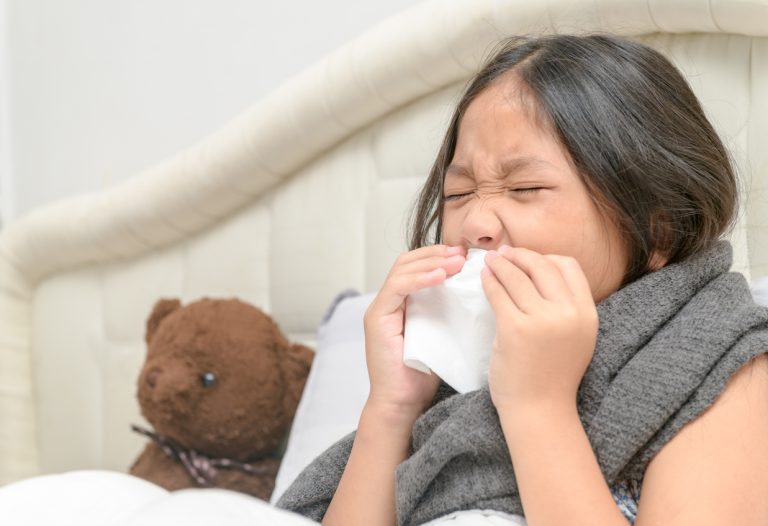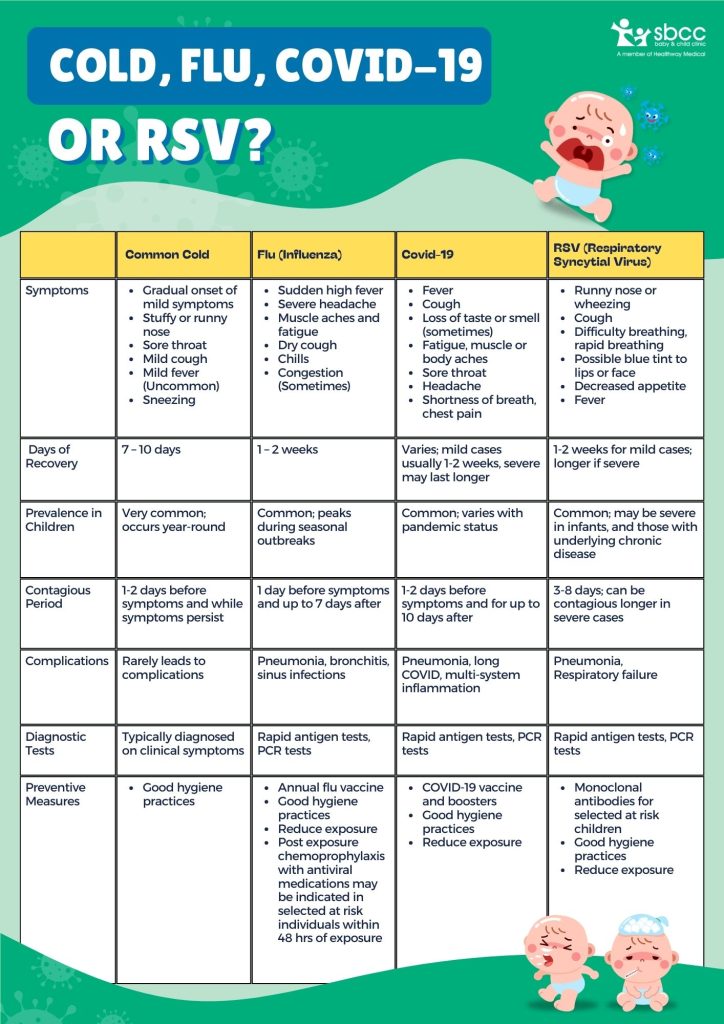Respiratory Illness in Kids: Cold, Flu, Covid-19 or RSV?

It’s common for kids to fall sick, especially during virus season. But wait—did your child come down with just a common cold, or could it be the flu, COVID-19, or RSV? It can be tricky to pinpoint exactly what’s causing their symptoms. Don’t worry! This is a guide for you to understand more about each symptom and when to seek professional help.
What’s the Difference Between a Common Cold, Flu, COVID-19, and RSV?
1. Common Cold
The common cold is a viral infection affecting the upper respiratory tract
. It is one of the most common infections, with minor symptoms including a stuffy or runny nose, sore throat, and cough. Serious health problems are uncommon, and colds are typically treated with homemade treatments and over-the-counter pharmaceuticals. Causes: Primarily caused by rhinoviruses, but other viruses like coronaviruses and adenoviruses can also be involved. Rhinoviruses usually cause mild symptoms but can lead to more severe sickness in those with compromised immune systems or underlying disorders.
2. Flu (Influenza Infection)
What it is:
The flu is a contagious respiratory illness caused by influenza viruses, which affects people of all ages and can trigger seasonal outbreaks. It attacks the human respiratory tract (nose, throat, and lungs), causing inflammation of the membranes. The flu typically strikes suddenly, with severe symptoms that can disrupt daily activities. In Singapore, influenza occurs all year, with peak seasons from December to February and May to July.
Causes:
Influenza viruses (types A and B) cause the flu. Respiratory droplets carry these viruses when an infected person coughs, sneezes or speaks.
3. Covid-19
What It Is:
COVID-19 is an infectious disease caused by the SARS-CoV-2 virus. It was discovered in late 2019 and has since caused a global pandemic. It typically affects the respiratory system but can also affect other organs. Symptoms can range from mild to severe, such as major breathing difficulties and hospitalisation.
Causes:
The virus spreads via respiratory droplets, close contact with sick persons, and contaminated surfaces. It is highly contagious and can be transmitted by those who are asymptomatic or pre-symptomatic.
4. RSV (Respiratory Syncytial Virus)
What It Is:
RSV is a common respiratory virus that affects the lungs and breathing airways. It is more severe in infants and young children, particularly those with underlying medical conditions, resulting in serious respiratory problems. Severe cases may require hospitalisation for supportive care, such as oxygen therapy.
Causes:
RSV spreads through respiratory droplets and through contacting infected surfaces. It is highly contagious and can quickly spread to young children and newborns.
What's The Difference? - The Ultimate Guide

What to Do if Your child Shows Symptoms?
1. Manage Symptoms at Home
Rest and Hydration
- Ensure Comfort: Make sure your child gets plenty of rest. Rest helps the body fight off the infection and recover more quickly.
- Stay Hydrated: Keep your child hydrated by providing plenty of fluids such as water, clear broths, or oral rehydration treatments. Proper hydration is essential for healing and to avoid dehydration.
Over-the-Counter Remedies
- Cold and Flu Medications: For colds and mild flu symptoms, over-the-counter medications such as decongestants, pain relievers and cough syrups may be used to alleviate discomfort. Always consult with your healthcare practitioner before delivering any medicines to your child, especially if it’s for the first time. Over-the-counter (OTC) cold and cough medicines are not recommended for children younger than two.
Home Comfort Measures
- Humidifier: Using a cool-mist humidifier in your child’s room can help ease congestion and soothe irritated airways.
- Saline Nasal Drops: For nasal congestion, saline drops can help clear mucus and ease breathing.
- Warm Liquids: Warm teas or broths can help soothe a sore throat and provide comfort.
What It Is:
The common cold is a viral infection affecting the upper respiratory tract. It is one of the most common infections, with minor symptoms including a stuffy or runny nose, sore throat, and cough. Serious health problems are uncommon, and colds are typically treated with homemade treatments and over-the-counter pharmaceuticals.
Causes:
Primarily caused by rhinoviruses, but other viruses like coronaviruses and adenoviruses can also be involved. Rhinoviruses usually cause mild symptoms but can lead to more severe sickness in those with compromised immune systems or underlying disorders.
2. Monitor Symptoms and Seek Medical Advice If Necessary
If your child’s symptoms worsen or if new, severe symptoms develop, consult a healthcare provider. Consult a doctor if your child has any of the following symptoms :
- Difficulty Breathing: If your child has difficulty breathing or shows signs of respiratory distress, such as rapid or laborious breathing, flaring nostrils, or blue-tinged lips or face.
- High Fever: A persistent high fever (above 104°F or 40°C) that doesn’t improve with medication, or if your child is younger than 3 months and has a fever of 100.4°F (38°C) or higher.
- Dehydration: Signs of dehydration, such as reduced urination, dry mouth, or a lack of tears when crying.
- Persistent Pain or Pressure: Pain in the chest or abdomen that doesn’t go away.
- Unresponsiveness or Severe Fatigue: If your child is unusually drowsy, unresponsive, or has difficulty waking up.
3. Emergency Situations
Seek emergency medical care if your child exhibits any of the following:
- Severe Breathing Problems: Continuous difficulty breathing.
- Convulsions or Seizures: Uncontrolled jerking.
- Severe Weakness: Sudden and severe weakness or inability to move.
- High Risk: If your child has underlying health conditions that could be worsened by a respiratory illness, such as asthma, chronic lung disease, or heart conditions.
By managing mild symptoms at home and keeping an eye on any changes, you can help ensure your child’s comfort and prompt action if necessary. When in doubt, always speak with your healthcare providers to ensure your child receives proper care.
How to Prevent or Reduce Risk?
1. Vaccination

- Flu Vaccine: Ensure your child receives an annual flu vaccine. Influenza vaccination helps prevent influenza infection and reduces the risk of severe illness and associated complications, especially in the very young and those with underlying chronic disease.
- COVID-19 Vaccine: Keep up-to-date with COVID-19 vaccinations and boosters as recommended for your child’s age group.
2. Good Hygiene Practices

- Handwashing: Encourage frequent handwashing with soap and water, especially before eating and after coughing or sneezing.
- Avoid Touching Face: Teach your child to avoid touching their face, particularly their eyes, nose, and mouth.
3. Reduce Exposure

- Avoid Close Contact: Keep your child away from individuals who are sick and avoid crowded places during peak respiratory illness seasons. Use face masks.
- Cover Coughs and Sneezes: Teach your child to cover their mouth and nose with a tissue or their elbow when coughing or sneezing, and dispose of tissues properly.
4. Maintain a Healthy Environment

- Clean Surfaces: Regularly clean and disinfect frequently touched surfaces, such as doorknobs, light switches, and toys.
- Ventilation: Ensure good ventilation in your home by opening windows or using air purifiers to reduce the concentration of airborne viruses.
Conclusion
Navigating the symptoms of flu, cold, COVID-19, and RSV can be complex, as these respiratory illnesses often overlap. In less severe situations, prioritise your child’s health by relieving their symptoms and taking preventive measures to decrease the chance of infection. Keep a close eye on their symptoms, and don’t hesitate to seek medical advice for an accurate diagnosis and early treatment. If you have any concerns or require expert counsel, the SBCC Baby and Child Clinic is here to support you every step of the journey.






